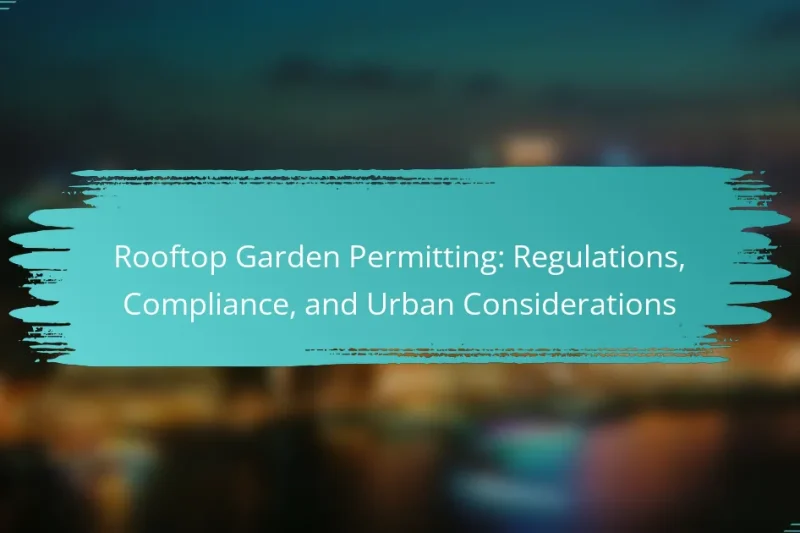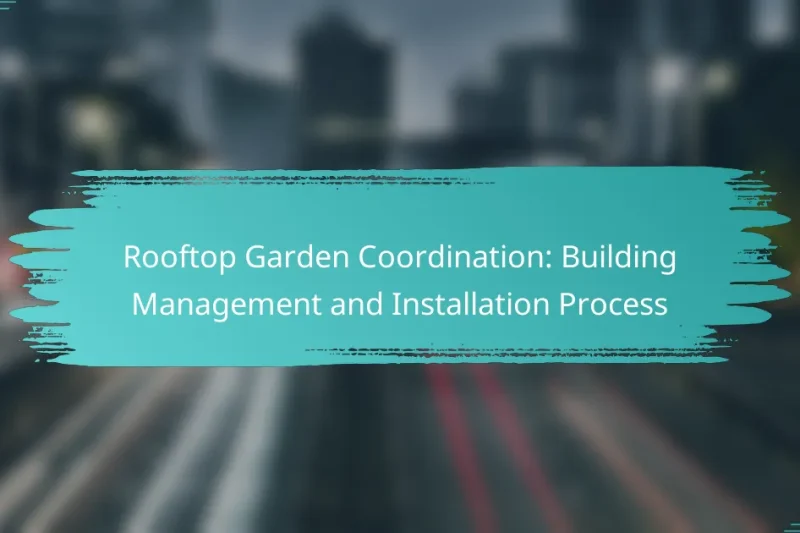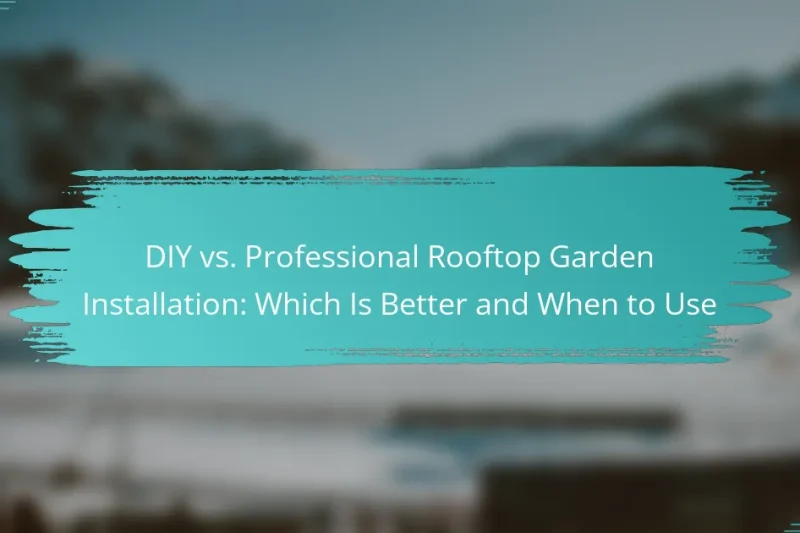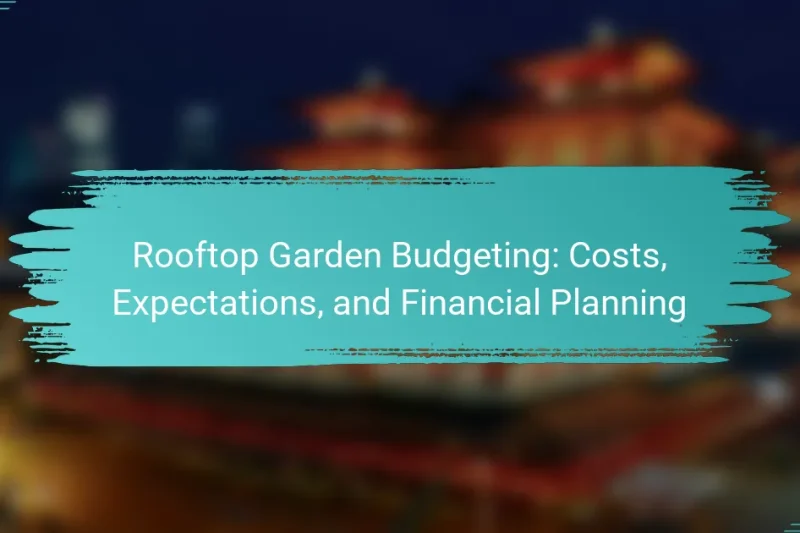Rooftop gardens are becoming increasingly popular in urban areas, but establishing one requires careful attention to … Rooftop Garden Permitting: Regulations, Compliance, and Urban ConsiderationsRead more
Rooftop Garden Installation Process
The rooftop garden installation process is a comprehensive approach to converting a flat roof into a vibrant green space. It encompasses essential steps such as site assessment, design creation, material selection, and installation, followed by a final inspection to ensure sustainability and functionality.
Rooftop Garden Coordination: Building Management and Installation Process
Rooftop garden coordination is essential for transforming urban spaces into vibrant green areas that enhance both … Rooftop Garden Coordination: Building Management and Installation ProcessRead more
Rooftop Garden Timeline: Project Phases and Completion Expectations
Creating a rooftop garden involves a structured timeline that can span from a few weeks to … Rooftop Garden Timeline: Project Phases and Completion ExpectationsRead more
DIY vs. Professional Rooftop Garden Installation: Which Is Better and When to Use
When deciding between a DIY rooftop garden installation and hiring professionals, it’s important to consider your … DIY vs. Professional Rooftop Garden Installation: Which Is Better and When to UseRead more
Rooftop Garden Contractor: Selection Criteria and Key Considerations
Selecting the right contractor for your rooftop garden is crucial for achieving a successful and sustainable … Rooftop Garden Contractor: Selection Criteria and Key ConsiderationsRead more
Rooftop Garden Budgeting: Costs, Expectations, and Financial Planning
Creating a rooftop garden can be a rewarding endeavor, but it requires careful budgeting to manage … Rooftop Garden Budgeting: Costs, Expectations, and Financial PlanningRead more
What is the rooftop garden installation process?
The rooftop garden installation process involves several key steps to transform a flat roof into a green space. This process includes site assessment, design creation, material selection, installation, and final inspection to ensure the garden is sustainable and functional.
Site assessment and planning
The first step in the rooftop garden installation process is conducting a thorough site assessment. This involves evaluating the roof’s structural integrity, load capacity, and existing drainage systems to ensure they can support the additional weight of a garden.
During planning, consider local climate conditions, sunlight exposure, and wind patterns, as these factors will influence plant selection and garden layout. Engaging with a professional can help navigate local regulations and building codes that may apply.
Design and layout creation
Once the site assessment is complete, the next step is to create a detailed design and layout for the rooftop garden. This includes selecting the types of plants, arranging them for aesthetic appeal, and planning pathways or seating areas.
Utilize design software or sketches to visualize the garden. Ensure the design incorporates adequate drainage and irrigation systems to maintain plant health, especially in areas with heavy rainfall or prolonged dry spells.
Material selection
Choosing the right materials is crucial for a successful rooftop garden installation. Select lightweight soil mixes, durable planters, and appropriate waterproofing membranes to protect the building structure.
Consider using sustainable materials, such as recycled plastics or wood, for planters and pathways. Ensure that all materials are suitable for outdoor use and can withstand local weather conditions.
Installation execution
The installation phase involves preparing the roof, laying down waterproofing layers, and installing the garden components according to the design plan. Begin by ensuring proper drainage to prevent water pooling.
Carefully place soil and plants, following the layout created earlier. It’s essential to monitor the installation process for any issues that may arise, such as improper drainage or structural concerns.
Final inspection and maintenance setup
After installation, conduct a final inspection to ensure everything is in place and functioning correctly. Check for proper drainage, secure plant placements, and overall aesthetic appeal.
Establish a maintenance plan that includes regular watering, weeding, and seasonal plant care. Consider setting up an irrigation system to simplify watering, especially in warmer months.
How much does rooftop garden installation cost in urban areas?
The cost of rooftop garden installation in urban areas typically ranges from several thousand to tens of thousands of dollars, depending on various factors such as size, materials, and design complexity. Urban settings often increase costs due to accessibility challenges and local regulations.
Cost breakdown by materials
Material costs for rooftop gardens can vary significantly based on the chosen plants, soil, and structural components. Common materials include lightweight soil, drainage systems, and various types of vegetation, which can range from low-maintenance succulents to more elaborate flower arrangements.
For instance, lightweight soil can cost between $30 to $60 per cubic yard, while drainage systems may add another $1,000 to $3,000 depending on the complexity. Additionally, the choice of plants can influence the overall budget, with some exotic species costing much more than local varieties.
Labor costs in major cities
Labor costs for installing a rooftop garden can be substantial, especially in major urban areas. Skilled labor rates often range from $50 to $150 per hour, depending on the region and the expertise required for installation.
In cities like New York or San Francisco, labor costs can be on the higher end of this spectrum due to the demand for experienced landscapers familiar with rooftop installations. It’s advisable to obtain multiple quotes to ensure competitive pricing.
Average pricing ranges
The average pricing for rooftop garden installations generally falls between $15 to $50 per square foot. This estimate includes materials, labor, and design elements, but can vary widely based on specific project requirements.
For a small rooftop garden of about 200 square feet, costs might start around $3,000 to $10,000, while larger or more intricate designs can exceed $20,000. Always consider potential additional costs for permits or structural assessments, especially in urban environments where regulations may be stricter.
What are the benefits of rooftop gardens?
Rooftop gardens offer numerous advantages, including environmental benefits, increased property value, and improved air quality. These gardens transform unused spaces into vibrant ecosystems that contribute positively to urban living.
Environmental advantages
Rooftop gardens help mitigate the urban heat island effect by providing natural insulation and reducing the need for air conditioning. They also manage stormwater runoff, which can decrease flooding and reduce the burden on municipal drainage systems.
Additionally, these gardens promote biodiversity by providing habitats for various species, including birds and pollinators. Incorporating native plants can further enhance these environmental benefits by supporting local ecosystems.
Increased property value
Installing a rooftop garden can significantly enhance the aesthetic appeal of a property, making it more attractive to potential buyers or renters. Properties with green spaces often see an increase in market value, sometimes by tens of percent compared to similar properties without gardens.
Moreover, the unique appeal of a rooftop garden can set a property apart in competitive real estate markets, especially in urban areas where outdoor space is limited. This can lead to quicker sales or higher rental rates.
Improved air quality
Rooftop gardens contribute to better air quality by filtering pollutants and absorbing carbon dioxide. The plants in these gardens can capture particulate matter and other harmful substances, leading to cleaner air in densely populated areas.
Furthermore, the presence of greenery can help lower ambient temperatures, which can reduce the formation of ground-level ozone, a harmful air pollutant. This improvement in air quality can have significant health benefits for residents and workers in urban environments.
What factors should be considered before installation?
Before installing a rooftop garden, it is crucial to evaluate several key factors that can impact the success and safety of the project. These include the structural integrity of the building, local zoning regulations, and effective water drainage systems.
Structural integrity of the building
Assessing the structural integrity of the building is essential to ensure it can support the additional weight of a rooftop garden. Most rooftops can handle a load of around 15-20 pounds per square foot, but this can vary based on the building’s design and materials.
Consult with a structural engineer to evaluate the roof’s capacity and identify any necessary reinforcements. Ignoring this step could lead to serious safety hazards and costly repairs.
Local zoning regulations
Local zoning regulations dictate what can be built on rooftops, including gardens. These regulations can vary significantly by city or municipality, so it’s important to check with local authorities before proceeding.
Some areas may require permits or have restrictions on the height or type of vegetation used. Familiarizing yourself with these regulations can save time and prevent legal issues down the line.
Water drainage systems
Effective water drainage systems are critical for maintaining the health of a rooftop garden and preventing water damage to the building. Ensure that the existing drainage can handle the additional water from irrigation and rainfall.
Consider implementing a drainage layer in the garden design to facilitate proper water flow and avoid pooling. Regular maintenance of the drainage system is also necessary to ensure it functions correctly over time.
Which plants are suitable for rooftop gardens in temperate climates?
In temperate climates, rooftop gardens thrive with a variety of plants that can withstand fluctuating temperatures and varying moisture levels. Suitable options include succulents, herbs, vegetables, perennials, and ornamental grasses, each offering unique benefits and aesthetic appeal.
Succulents and drought-resistant plants
Succulents and drought-resistant plants are ideal for rooftop gardens due to their ability to retain water and survive in dry conditions. Varieties such as sedum, agave, and aloe vera require minimal maintenance and can flourish in well-drained soil.
When selecting succulents, consider their sunlight requirements and ensure they receive adequate light exposure. Grouping them based on their water needs can also enhance their growth and overall health.
Herbs and vegetables
Herbs and vegetables can be highly rewarding in rooftop gardens, providing fresh produce and culinary benefits. Popular choices include basil, parsley, tomatoes, and peppers, which generally thrive in full sun and well-drained soil.
To maximize yield, use containers that allow for proper drainage and consider companion planting to enhance growth. Regular watering and fertilization will support healthy development, especially during warmer months.
Perennials and ornamental grasses
Perennials and ornamental grasses add structure and visual interest to rooftop gardens. Plants like lavender, coneflower, and fountain grass are resilient and can survive seasonal changes while providing color and texture throughout the year.
When choosing perennials, opt for varieties that are hardy in your specific climate zone. Grouping plants with similar water and light needs can simplify maintenance and ensure a thriving garden.





